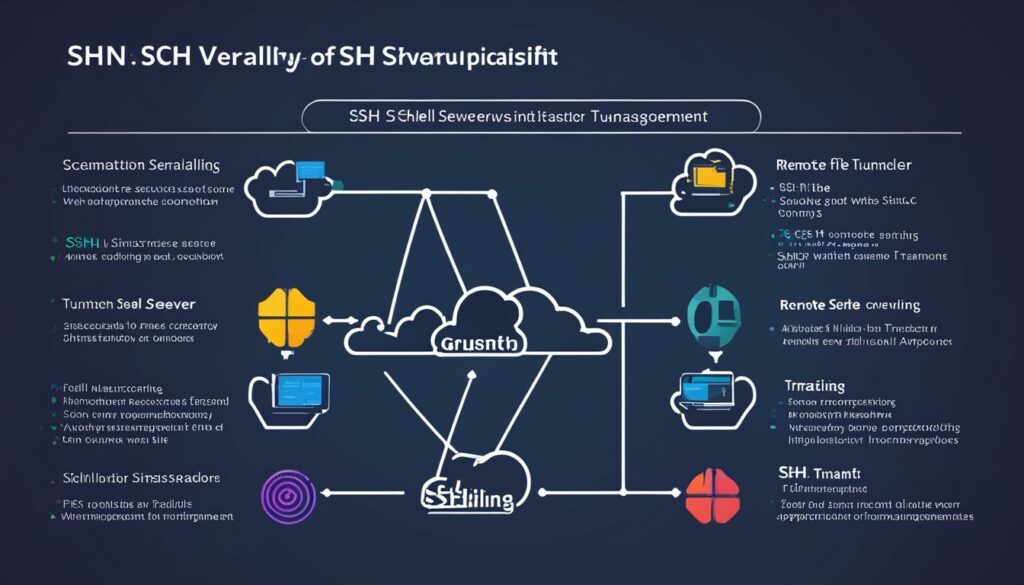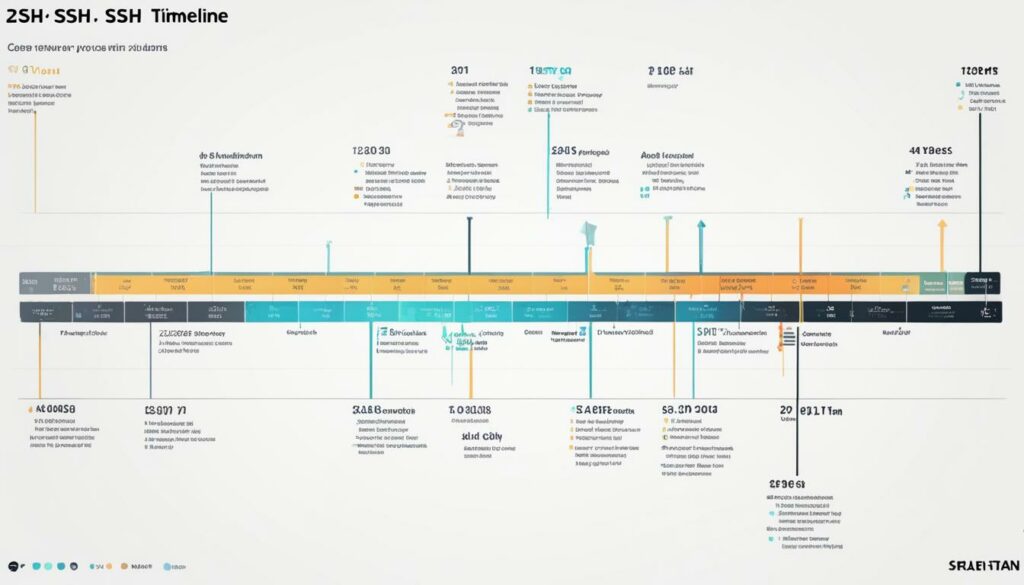When it comes to managing and accessing computers over unsecured networks, security is a top concern. That’s where SSH, or Secure Shell, comes in. SSH is a powerful network protocol that provides a secure way for system administrators, like you, to remotely access and manage computers with peace of mind.
With SSH, you can say goodbye to the worries of unprotected connections. It offers strong authentication, encrypted data communications, and a variety of capabilities that make it a go-to tool for secure web administration.
Whether you need to execute commands, transfer files, or create secure tunnels for other application protocols, SSH has got you covered. It follows the client-server model, supports terminal emulation, and is present in all data centers, making it a trusted and widely-used solution.
Ready to unlock the full potential of SSH? BoostedHost offers exceptional WordPress Hosting that ensures optimal performance for all your secure web administration needs. Sign up now through this link: www.boostedhost.com/wordpress-hosting.
Key Takeaways:
- SSH is a secure network protocol used for remote system management and secure file transfers.
- It provides strong authentication and encrypted data communications to protect against unauthorized access.
- SSH follows the client-server model and supports terminal emulation and file transfers.
- BoostedHost offers WordPress Hosting that ensures optimal performance for secure web administration tasks.
- Sign up now for BoostedHost’s WordPress Hosting to unleash the power of SSH in your web administration.
How does SSH work?
SSH, or Secure Shell, is a network protocol that enables a secure connection between a client and a server. Understanding how SSH works is essential for anyone involved in web administration or remote system management.
To establish an SSH connection, the client initiates the process by sending a request to the server. The server responds with its public key, which the client uses to authenticate the server’s identity. This step ensures that the client is connecting to the correct server and not a malicious imposter.
Once the server is authenticated, the SSH protocol utilizes robust encryption algorithms to safeguard the data transmitted between the client and the server. This encryption protects sensitive information from being intercepted or accessed by unauthorized parties.
SSH supports multiple authentication methods, including password and public key authentication. With password authentication, the client must enter a username and password combination to access the server. Public key authentication, on the other hand, involves using cryptographic key pairs. The client possesses the private key, while the server holds the corresponding public key. This method offers stronger security and is commonly used for automation and single sign-on (SSO) purposes.
Once the SSH connection is established, users can securely interact with the remote server. SSH provides secure terminal sessions, allowing administrators to execute commands on the server and manage network resources. It also facilitates secure file transfers, enabling users to securely transfer files between the client and server.
SSH enables secure terminal sessions, remote command execution, and file transfers, ensuring that your data remains protected throughout the entire process.
SSH Connection Types
| Connection Type | Description |
|---|---|
| Single-User | Allows a single user to connect to the server for remote administration or file transfers. |
| Multi-User | Enables multiple users to connect to the server concurrently, each with their own authentication credentials. |
| Tunneling | Creates a secure connection between two networks, enabling traffic from one network to pass through the other securely. |
SSH’s ability to establish secure connections and provide authentication ensures that your data is protected during remote access and file transfers. It has become an integral tool for system administrators and web administrators alike, offering a safe and reliable method for managing and securing network resources.
What is SSH used for?
SSH, or Secure Shell, is a versatile protocol that serves various purposes. It provides a secure avenue for remote access, file transfers, and remote command execution. With its robust encryption and authentication capabilities, SSH is widely utilized in managing routers, server hardware, virtualization platforms, operating systems, and systems management and file transfer applications.
One of the key applications of SSH is secure remote access. Organizations can securely access and manage resources on remote servers through SSH, ensuring that sensitive information remains protected during transmission. SSH also facilitates secure and interactive file transfer sessions, enabling users to securely transfer files between different systems.
Furthermore, SSH plays a significant role in remote command execution. It allows for the seamless execution of commands on remote devices, enabling efficient management of network infrastructure components. This feature is particularly valuable for automating processes and integrating applications, enhancing productivity and efficiency.
“SSH provides a secure channel for accessing and managing resources on remote servers. It is a reliable tool for secure site management and offers a wide range of capabilities for remote access, file transfers, and command execution.”
Applications of SSH:
- Secure remote access to servers and resources
- Secure and interactive file transfers between systems
- Remote command execution for efficient management of network infrastructure
- Automation of processes and seamless integration of applications
Understanding the applications and benefits of SSH is crucial for organizations seeking secure and efficient remote management of their systems. By leveraging the power of SSH, businesses can ensure the confidentiality and integrity of their data while maintaining streamlined operations.

Secure Shell capabilities
SSH (Secure Shell) offers a wide range of capabilities that make it an essential tool for managing and securing various aspects of IT infrastructure. Whether you need secure remote access, file transfers, or remote command execution, SSH has you covered.
Secure Remote Access
With SSH, you can securely access SSH-enabled network systems from anywhere, giving you the flexibility to manage your infrastructure without compromising security. Whether you’re connecting to a server, router, or other network device, SSH ensures that your remote access is secure and protected.
Secure File Transfers
Transferring files securely is crucial to protect sensitive data during transit. SSH provides secure and interactive file transfer sessions, allowing you to safely move files between computers. Whether you’re uploading, downloading, or syncing files, SSH ensures that your data remains encrypted and protected.
Automated and Secured File Transfers
SSH is not only useful for manual file transfers but also for automating file transfer processes. By scripting SSH commands, you can easily automate file transfers to enhance efficiency and reduce manual errors. With SSH, you can ensure that your automated file transfers are secure and protected, maintaining the integrity of your data.
Secure Issuance of Commands on Remote Devices
SSH allows you to securely issue commands on remote devices, giving you full control over your network infrastructure. Whether you need to execute configuration changes, troubleshoot issues, or perform maintenance tasks, SSH ensures that your commands are transmitted securely and cannot be intercepted or tampered with.
Secure Management of Network Infrastructure Components
From routers to servers and virtualization platforms, SSH offers a secure and efficient way to manage various components of your network infrastructure. With SSH, you can securely configure, monitor, and maintain critical systems, ensuring the security and stability of your network.
“SSH’s secure shell capabilities play a vital role in ensuring the smooth operation and protection of IT infrastructure. From secure remote access to encrypted file transfers and automated processes, SSH provides the necessary tools for effective network management.”

Overall, SSH’s features and functions make it a versatile and reliable solution for managing and securing IT infrastructure. Whether you’re a system administrator, an IT professional, or a security specialist, SSH is an indispensable tool for secure access, file transfers, and command execution.
Next, let’s take a closer look at the history of SSH and how it has evolved over the years.
The History of SSH
SSH, which stands for Secure Shell, has a fascinating history that dates back to 1995. It was originally developed by Tatu Ylonen as a response to a hacking incident in the Finnish university network.
The first version of SSH was introduced in 1995, but it was later deprecated due to security vulnerabilities. In 2006, the current version, SSH-2, was standardized by the IETF (Internet Engineering Task Force). This new version brought significant improvements in security by implementing strong encryption algorithms.
After creating SSH, Tatu Ylonen founded SSH Communications Security Corp to provide commercial support for the protocol. Today, SSH is widely used in millions of networks and environments worldwide for secure remote access, file transfers, and remote command execution.
Let’s take a look at the development of SSH over the years in the table below:

SSH Versions Timeline
| SSH Version | Year | Highlights |
|---|---|---|
| SSH-1 | 1995 | Initial version developed by Tatu Ylonen |
| SSH-2 | 2006 | Standardized by the IETF, introduced strong encryption algorithms |
Secure Shell security issues
While SSH is generally considered secure, it is important for organizations to be aware of potential security issues. By addressing these vulnerabilities, organizations can enhance the overall security of their systems and data.
Poor key management
One of the major risks in SSH security is poor key management. Unmanaged SSH keys can lead to unauthorized access and compromise system security. To mitigate this risk, organizations should establish proper processes for managing SSH keys:
- Create strong, unique SSH keys for each user or system.
- Regularly rotate SSH keys to limit their exposure over time.
- Remove SSH keys of users who no longer require access.
By implementing these key management practices, organizations can better control access to their systems and prevent unauthorized use of SSH keys.
Management of host keys
Another security concern in SSH is the management of host keys stored on client systems. These host keys are used to verify the identity of SSH servers during the connection process. To maintain the integrity of SSH connections, organizations should:
- Regularly check and verify the host keys stored on client systems.
- Implement mechanisms to detect and address any unauthorized modifications to host keys.
By properly managing host keys, organizations can prevent potential man-in-the-middle attacks and ensure the authenticity of SSH servers.
Cautious use of SSH commands in scripts
Developers should exercise caution when incorporating SSH commands into scripts. If credentials are hard-coded in the source code, they may be exposed and pose a security risk. It is important to follow these best practices:
- Use environment variables or secure credential storage solutions to store SSH credentials.
- Limit the exposure of SSH commands within the script to minimize the risk of credential exposure.
By adopting these precautions, developers can ensure that SSH commands within scripts do not inadvertently expose sensitive information.
To secure your SSH connections and protect your systems, it is essential to address these security issues and implement best practices for SSH key management, host key management, and secure use of SSH commands.
“Proper SSH key management and cautious use of SSH commands are crucial for ensuring the security of your systems and preventing unauthorized access.” – Your IT Security Team

| Security Issue | Best Practices |
|---|---|
| Poor key management | Create strong, unique SSH keys Regularly rotate SSH keys Remove unused SSH keys |
| Management of host keys | Regularly verify host keys Detect and address unauthorized modifications |
| Cautious use of SSH commands | Store SSH credentials securely Limit exposure of SSH commands in scripts |
SSH vs. Telnet
When it comes to remote terminal sessions, SSH and Telnet are two popular options. However, there are significant differences in terms of security. SSH, or Secure Shell, provides better security compared to Telnet, which is a non-protected login protocol.
SSH security advantages:
- SSH uses public key cryptography for identity verification, ensuring a higher level of authentication compared to Telnet.
- SSH encrypts session commands and output, protecting sensitive data from unauthorized access.
- SSH supports terminal emulation, allowing users to interact with remote systems securely.
- SSH can be used for remote command execution, file transfers, and even tunneling other applications.
Telnet vulnerabilities:
Telnet, on the other hand, lacks the robust security features of SSH and poses several vulnerabilities:
- Telnet traffic is transmitted in clear text, making it susceptible to eavesdropping and interception.
- Telnet does not provide encryption or authentication, increasing the risk of unauthorized access to sensitive information.
- Telnet does not support advanced features like terminal emulation, limiting its functionality compared to SSH.
It is strongly recommended to use SSH instead of Telnet for enhanced security when establishing remote terminal sessions or performing file transfers.
Sign up for WordPress Hosting from BoostedHost to optimize the performance of your website. Take advantage of their reliable and secure SSH access for seamless management of your content and data. BoostedHost offers industry-leading hosting solutions designed to meet your specific needs.
SSH vs. SSL/TLS
When it comes to secure communication protocols, SSH and SSL/TLS are two popular choices. While they both rely on public/private key pairs for authentication, there are significant differences between them that you should be aware of.
SSH, or Secure Shell, authenticates each connection individually. This means that both the client and server are authenticated, ensuring a secure and trustworthy connection. SSH also encrypts all data transmitted between the client and server, providing both encryption and integrity protection. This ensures that the data remains secure and untampered with during transmission.
On the other hand, SSL/TLS, commonly used in HTTPS connections, authenticates the server only. While this provides a level of assurance that you’re connecting to a legitimate server, it doesn’t authenticate the client connecting to the server. Additionally, SSL/TLS can enable encrypted connections without authentication, or authenticated connections without encryption. This means that there may be instances where data is transmitted without proper encryption or where authentication is not required.
Overall, SSH offers a more comprehensive security approach compared to SSL/TLS. It ensures that both the client and server are authenticated, encrypts all data transmissions, and provides integrity protection. These features make SSH an excellent choice for secure remote access, file transfers, and other sensitive network activities.
At a glance: SSH vs. SSL/TLS
| SSH | SSL/TLS |
|---|---|
| Authenticates each connection individually | Authenticates the server only |
| Encrypts all data transmissions | May have encrypted or unencrypted connections |
| Provides integrity protection | No specific integrity protection |
If you prioritize strong authentication, encryption, and integrity protection, SSH is the recommended choice for secure communication. However, SSL/TLS still plays an important role in securing web connections and is widely used for HTTPS.
Understanding the differences between SSH and SSL/TLS helps you make informed decisions when it comes to securing your network and protecting sensitive data. Whether you’re a system administrator, developer, or individual user, it’s essential to choose the right protocol to ensure the safety of your online communications.
Typical uses of the SSH protocol
The SSH protocol is widely utilized across corporate networks for a variety of purposes, offering secure access to resources, automated processes, file transfers, remote command execution, and efficient network infrastructure management. IT professionals and information security specialists rely on SSH to configure, manage, and maintain critical systems and components, ensuring the utmost security and integrity. With SSH, you gain a robust and secure mechanism to manage your SSH clients remotely, and it’s even embedded in numerous file transfer and systems management solutions.
The SSH Protocol and Strong Authentication
When it comes to secure authentication methods, the SSH protocol offers several options that ensure robust security for accessing remote systems. Two commonly used authentication methods within SSH are passwords and public key authentication.
Password authentication: This method involves users entering a password to validate their identity and gain access to the server. While password authentication is widely used, it has some drawbacks. Passwords can be vulnerable to brute-force attacks or easily forgotten, leading to potential security risks.
Public key authentication: Public key authentication, using SSH keys, has become the preferred method for strong authentication. SSH keys are cryptographic key pairs consisting of a public key, stored on the server, and a private key, securely stored on the user’s device. When a user attempts to connect to a server, the server checks if the user possesses the private key corresponding to the public key stored on the server.
SSH keys provide enhanced security as they eliminate the need to transmit passwords over the network. Additionally, public key authentication is commonly used for automation and single sign-on scenarios. SSH keys are widely adopted by system administrators, developers, and configuration management tools for seamless and secure access to remote systems.
Automation: SSH keys play a vital role in automation processes by allowing scripts and applications to securely connect to remote servers without requiring manual password authentication. This makes it easier to automate tasks such as backups, configuration management, and deployment processes, saving time and effort.
Single Sign-On (SSO): SSH keys also enable single sign-on functionality, allowing users to access multiple systems using a single SSH key pair. With SSO, users can authenticate once using their SSH key, and then seamlessly connect to various servers or services that recognize the same SSH key, streamlining the authentication process.
Overall, the SSH protocol’s support for strong authentication methods like SSH keys enhances security, simplifies automation, and enables seamless single sign-on experiences for users.
BoostedHost provides reliable and secure SSH hosting solutions to support your SSH-based authentication needs. Sign up now through this link: www.boostedhost.com/ssh-hosting.
The Security and Encryption of SSH
The SSH protocol plays a crucial role in ensuring the security and privacy of your data during transmission between the client and server. It achieves this through the implementation of robust encryption and hashing algorithms, safeguarding your sensitive information from unauthorized access.
SSH utilizes industry-standard encryption techniques, including the Advanced Encryption Standard (AES), which is trusted by organizations worldwide for its strong security. This encryption algorithm ensures that your data remains protected and confidential, providing peace of mind when transferring files or executing commands remotely.
In addition to encryption, SSH employs secure hashing algorithms such as the Secure Hash Algorithm 2 (SHA-2). These hashing algorithms play a vital role in verifying the integrity of the data transmitted. By generating unique hash values for the transmitted data, SSH allows the recipient to verify that the information has not been tampered with during transit.
“SSH provides the foundation for secure remote access, encryption of sensitive data, and the protection of valuable assets.”
All SSH traffic is encrypted, ensuring that any actions you perform, whether it’s transferring files, browsing the web, or running commands, remain confidential and protected. This ensures that your sensitive information cannot be intercepted or viewed by unauthorized parties, preserving your data privacy and maintaining the integrity of your communications.
It’s worth mentioning that the SSH protocol also supports secure tunneling, allowing you to establish encrypted connections for other application protocols. This enables you to extend the security features of SSH to other network services, ensuring comprehensive protection for your entire system.
| SSH Encryption Algorithms | SSH Hashing Algorithms |
|---|---|
| AES (Advanced Encryption Standard) | SHA-2 (Secure Hash Algorithm 2) |
| 3DES (Triple Data Encryption Standard) | MD5 (Message Digest Algorithm 5) |
| Blowfish | SHA-1 (Secure Hash Algorithm 1) |
Table: Common SSH Encryption and Hashing Algorithms
Conclusion
In conclusion, SSH (Secure Shell) is an essential network protocol that offers a secure way to access and manage computers over unsecured networks. It is widely used by system administrators and IT professionals for secure remote access, file transfers, and remote command execution. With strong authentication, encryption, and integrity protection, SSH provides a reliable solution for managing websites and ensuring safer online communication and data transfer.
Understanding SSH is crucial in today’s digital landscape, where the protection of sensitive information is paramount. By utilizing SSH, you can confidently access remote systems, transfer files securely, and execute commands without worrying about unauthorized access or interception. SSH’s robust security features, such as password authentication and encrypted data communications, make it an indispensable tool for system administrators and IT professionals worldwide.
To ensure optimal performance and security, we recommend WordPress Hosting from BoostedHost. Experience lightning-fast speeds, enhanced security measures, and reliable support for your website. Sign up now through this link: www.boostedhost.com/wordpress-hosting.
FAQ
Q: What is SSH?
A: SSH, also known as Secure Shell or Secure Socket Shell, is a network protocol that provides users with a secure way to access a computer over an unsecured network. It offers strong password authentication, public key authentication, and encrypted data communications.
Q: How does SSH work?
A: SSH works by establishing a secure connection between a client and a server. The client initiates the connection and authenticates the server using public key cryptography. After the connection setup, the SSH protocol uses strong encryption algorithms to protect the data exchanged between the client and server. SSH supports various authentication methods, including passwords and public key authentication. SSH allows for secure terminal sessions, remote command execution, and file transfers.
Q: What is SSH used for?
A: SSH is used for various purposes, including secure remote access, file transfers, and remote command execution. It is widely employed in managing routers, server hardware, virtualization platforms, operating systems, and systems management and file transfer applications. SSH enables secure and interactive file transfer sessions, providing a secure channel for accessing and managing resources on remote servers. It is also commonly used for automation, allowing for remote execution of commands and seamless integration of applications.
Q: What are the capabilities of SSH?
A: SSH provides several capabilities, including secure remote access to SSH-enabled network systems, secure and interactive file transfer sessions, automated and secured file transfers, secure issuance of commands on remote devices, and secure management of network infrastructure components. It is widely used for managing and securing various aspects of IT infrastructure.
Q: What is the history of SSH?
A: SSH was originally developed by Tatu Ylonen in 1995 as a response to a hacking incident in the Finnish university network. The first version of SSH appeared in 1995 and was later deprecated due to vulnerabilities. The current version, SSH-2, was standardized by the IETF in 2006. Tatu Ylonen founded SSH Communications Security Corp to provide commercial support for the protocol. Today, SSH is used in millions of networks and environments worldwide.
Q: What are the security issues with SSH?
A: Although SSH is generally considered secure, there are security issues that organizations should be aware of. Poor key management can be a major risk, as unmanaged SSH keys can lead to unauthorized access. Organizations should have proper processes in place for managing SSH keys, including creation, rotation, and removal. Another security concern is the management of host keys stored on client systems. Also, developers should exercise caution when incorporating SSH commands in scripts, as credentials may be exposed in the source code.
Q: How does SSH compare to Telnet?
A: SSH and Telnet are both used for remote terminal sessions, but SSH provides better security compared to Telnet. While Telnet is a non-protected login protocol, SSH uses public key cryptography for identity verification and encrypts session commands and output. SSH can also be used for remote command execution, file transfers, and tunneling other applications. It is recommended to use SSH instead of Telnet for enhanced security.
Q: What are the differences between SSH and SSL/TLS?
A: SSH and SSL/TLS are both protocols used for secure communication, but there are important differences between them. While both protocols rely on public/private key pairs for authentication, SSH authenticates each connection separately, whereas TLS authenticates the server only. SSH encrypts and authenticates all connections, providing both encryption and integrity protection. TLS, on the other hand, can enable encrypted connections without authentication or authenticated connections without encryption.
Q: What are the typical uses of the SSH protocol?
A: The SSH protocol is widely used in corporate networks for secure access to resources, automated processes, file transfers, remote command execution, and network infrastructure management. It is used by IT professionals and information security specialists to configure, manage, and maintain critical systems and components. SSH provides a secure mechanism for managing SSH clients remotely and is embedded in many file transfer and systems management solutions.
Q: How does the SSH protocol ensure security and encryption?
A: The SSH protocol ensures the security and integrity of data transmitted between the client and server through strong encryption and hashing algorithms. It uses industry-standard encryption algorithms, such as AES, and hash algorithms, such as SHA-2. All SSH traffic is encrypted, protecting user actions, whether it’s transferring files, browsing the web, or running commands. The protocol also supports secure tunneling for other application protocols.












